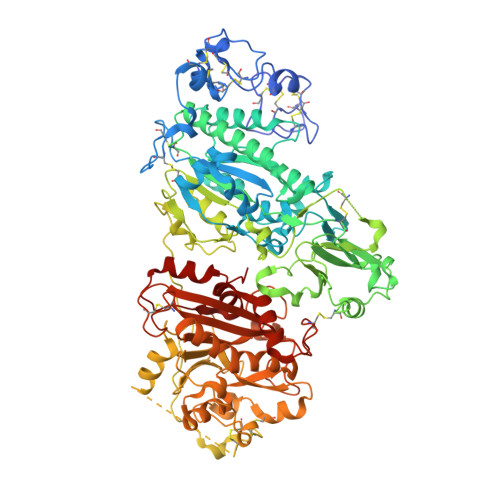Steroid binding to Autotaxin links bile salts and lysophosphatidic acid signalling.
Keune, W.J., Hausmann, J., Bolier, R., Tolenaars, D., Kremer, A., Heidebrecht, T., Joosten, R.P., Sunkara, M., Morris, A.J., Matas-Rico, E., Moolenaar, W.H., Oude Elferink, R.P., Perrakis, A.(2016) Nat Commun 7: 11248-11248
- PubMed: 27075612
- DOI: https://doi.org/10.1038/ncomms11248
- Primary Citation of Related Structures:
5DLT, 5DLV, 5DLW - PubMed Abstract:
Autotaxin (ATX) generates the lipid mediator lysophosphatidic acid (LPA). ATX-LPA signalling is involved in multiple biological and pathophysiological processes, including vasculogenesis, fibrosis, cholestatic pruritus and tumour progression. ATX has a tripartite active site, combining a hydrophilic groove, a hydrophobic lipid-binding pocket and a tunnel of unclear function. We present crystal structures of rat ATX bound to 7α-hydroxycholesterol and the bile salt tauroursodeoxycholate (TUDCA), showing how the tunnel selectively binds steroids. A structure of ATX simultaneously harbouring TUDCA in the tunnel and LPA in the pocket, together with kinetic analysis, reveals that bile salts act as partial non-competitive inhibitors of ATX, thereby attenuating LPA receptor activation. This unexpected interplay between ATX-LPA signalling and select steroids, notably natural bile salts, provides a molecular basis for the emerging association of ATX with disorders associated with increased circulating levels of bile salts. Furthermore, our findings suggest potential clinical implications in the use of steroid drugs.
Organizational Affiliation:
Division of Biochemistry, Netherlands Cancer Institute, 1066 CX Amsterdam, The Netherlands.
























